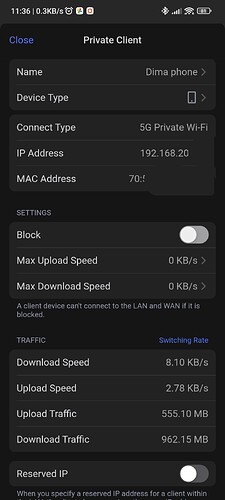so uncle, do you use the voip part on another router in cascade or don’t you use it?
You can use VoIP via another router or you could switch to direct device provisioning so the router does not matter - depends on your needs and phone provider. If you need VoIP really badly, a GL.iNet router will not help you.
Maybe there is something possible with OpenWrt itself, but I don‘t know about it.
I am not using Voip at the moment. But I will when I buy an ATA SIP. My configuration is Modem + Flint + ATA SIP (coming soon).
I don’t want to have 3 devices, when I could do all that with one.
I am from Spain @gaboIT
VOIP is not an important requirement for me, i’d like to use only for play and to learn something on voip side, i’m not familiar with it and my isp it provided to me credential
thank you all
hmm my knowledge is limited on voip, but i believe it should be definitely possible.
you have dect, flint 2 has no dect because its a different type wireless communication however the voip protocol can still be possible.
there are alot of opkg out there which can proxy voip traffic like siproxd I suspect they look familar to igmpproxy (igmpproxy is not relevant for voip but I’m refering configuration wise as how it looks), you also have asterisk and some other which may be very interesting.
but I think the better solution would be is buying a voip station in where you can setup all your voip settings which also has a dect module (some come with a ethernet port and one rj12/rj11 phone cable port) and then the only thing you have to do for OpenWrt is proxy traffic to the station ![]() , the only thing OpenWrt might be having issues to is SIP ALG but I have not looked into that too much.
, the only thing OpenWrt might be having issues to is SIP ALG but I have not looked into that too much.
edit
maybe you don’t even need anything as configuration because if the voip station talks as src → wan, the firewall condition has met meaning the connection is made in where the external party is allowed to talk back on the same line, but maybe i’m thinking to simple theres also passive ports ![]()
hello team, any package/app to generate/view a qr code for wifi guest ?
it should be easy visible in admin page…
Most OpenWrt people would not like to scan QR codes - because of security and privacy.
But you can easily create one by yourself: https://qifi.org/
You can install qrencode and then make some edits to have QR codes displayed on the LuCi login screen. But if you want QR codes displayed within the GL.iNet UI then you might need to submit a feature request?
If you’ve got a printer then it’d be much easier to do what @admon suggested.
people aware of security and privacy of course did not put their data on a website lol
anyway, that feature is pretty common on other vendor, on my opinion it should be added in gl.inet webgui
Download glinet app your phone and click share network. Will be appear qrcode for main WiFi and guest WiFi.
@solidus1983 - it didn’t work from the openwrt Acme. I tried on ubuntu and managed to generate. However, would have preferred to have an automated method to have the ssl’s updated on its own as expected
@tcp Not fully understanding your post here bud, are you saying that ACME is not working on my OpenWRT builds?
Pretty sure this is a mistake.
The screenshot tells me that @tcp is using the HTTP-challenge, which should work on every OpenWrt (at least if nobody removed the firewall itself).
@tcp You might want to have a look into the ACME script I wrote: Is there a way to get a letsencrypt certificate for the factory DDNS on the MT6000? - #4 by admon - Maybe just for understanding the commands and requirements.
Adguard Home’s blog page says you need to turn on encryption IF your AGH server “resides outside your network” as on a VPS (Virtual private server).
Does the app show a summary and a detailed graph or data rate of internet traffic? Coming from Asus, I miss not seeing this… Is there a way to enable it… Come to think of it, I don’t see it on the we page either.
Each client you can see traffic.
Another option you can use Adguard Home DHCP to see all traffic if I am right. But must be turn off itself router DHCP (LAN network).
I think this will get implemented on the next firmware releases like 4.6.* if Im not mistaken.
Thanks.
That’s useful, but a summary and live chart would be more handy rather than looking at each client.
Great, this is a useful enhancement to have if the webui can show the current stars but also have a historic chart with different time frames and scales that would be amazing. Even the top 5 or 10 devices using bandwidth would be helpful to see at a glance what is sucking up internet bandwidth when you are troubleshooting…
I was unable to choose the above options of encryption without installing certificates.
It notes above that : “If encryption is enabled, AdGuard Home admin interface will work over HTTPS, and the DNS server will listen for requests over DNS-over-HTTPS and DNS-over-TLS.”.
Therefore is it sure that certificates are not needed if installed on home router…?


